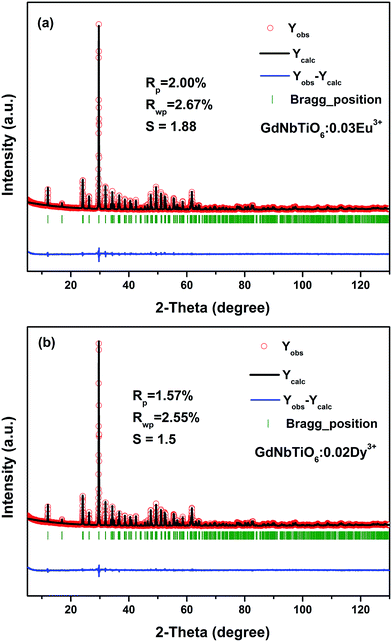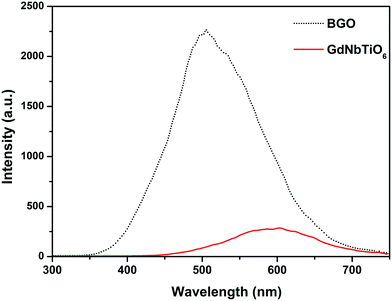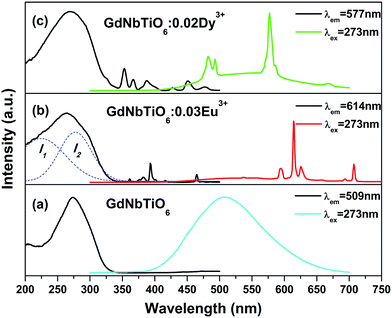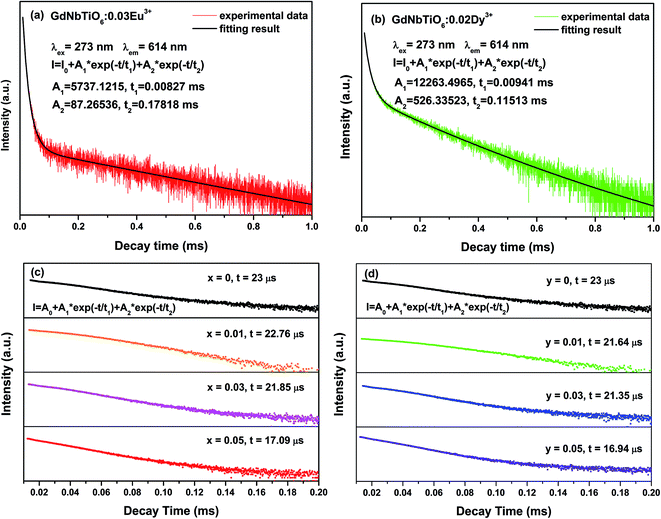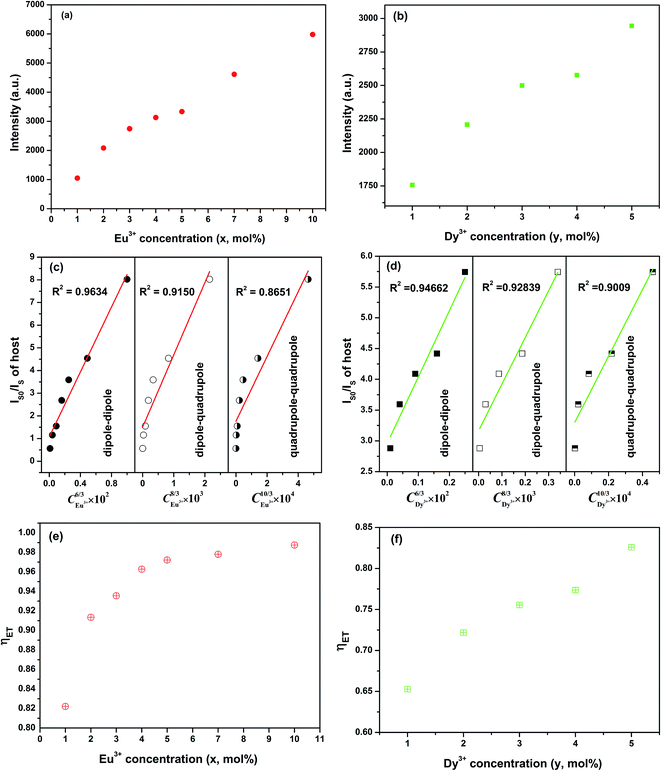Crystal structure, luminescence properties and energy transfer of Eu3+/Dy3+ doped GdNbTiO6 broad band excited phosphors
N. Liua,
J. Y. Si*a,
G. M. Cai*b and
Y. Taoc
aCollege of Mechanical & Electrical Engineering, Central South University of Forestry & Technology, Changsha 410004, P. R. China. E-mail: sjy98106@163.com; Fax: +86-0731-85016000; Tel: +86-731-85016000
bSchool of Materials Science and Engineering, Central South University, Changsha, Hunan 410083, P. R. China. E-mail: caigemei@csu.edu.cn; Fax: +86-731-88877732; Tel: +86-731-88877732
cLaboratory of Beijing Synchrotron Radiation, Institute of High Energy Physics, Chinese Academy of Sciences, Beijing 100039, P. R China
First published on 19th May 2016
Abstract
GdNbTiO6 is used as a host material for phosphors for the first time. Lanthanide ion (Eu3+/Dy3+) doped GdNbTiO6 phosphors were prepared by solid-state reaction, and the crystal structure, luminescence properties, and relevant luminescence mechanisms were investigated. The crystal structure of Eu3+/Dy3+ doped GdNbTiO6 was refined from powder XRD data by the Rietveld method, which is made up of irregular (Gd/Eu/Dy)3+O813− polyhedra and slightly distorted Nb(Ti)O6 octahedra forming a layered structure. The luminescence properties of the GdNbTiO6:Eu3+/Dy3+ phosphors were studied under ultraviolet (UV) and vacuum ultraviolet (VUV) excitation. The GdNbTiO6 host shows a broad emission band about the 400–650 nm region centered at 509 nm owing to the Nb(Ti)O6 octahedral groups, which has spectral overlap with f–f excitation transitions of Eu3+/Dy3+ in the doped samples. For red phosphor GdNbTiO6:Eu3+, a dominant emission peak at 614 nm was attributed to the 5D0 → 7F2 transition of Eu3+, which confirmed that Eu3+ ions are located at sites without inversion symmetry. The phosphor GdNbTiO6:Dy3+ shows bright yellow-green emission prevailing at 577 nm upon 273 nm excitation. With increasing activator concentration, the emission derived from the characteristic f–f transitions of Eu3+/Dy3+ is enhanced while the host emission is weakened, which is due to the energy transfer from the host to Eu3+/Dy3+. Considering the facile synthesis and excellent Eu3+/Dy3+ doped luminescence properties of this compound, self-activated GdNbTiO6 may be a good candidate as a host phosphor for use in various optical devices.
1. Introduction
Inorganic luminescent phosphors have been a long focus of research due to their good thermal and chemical stability and environmental friendliness. Rare earth ion-doped oxide phosphors are outstanding inorganic luminescent materials, and they can be excellently applied in lighting, display equipment, and solid-state lasers.1–3 Therefore, more efforts should be paid to the improvement of the existing oxide phosphors and development of new oxide phosphor materials for modern display systems.As is well known, lanthanide ion involved intra-4f transitions are barely affected by the external environment or crystal field on account of the shielding of the 4f orbital by the filled outer 5s and 5p orbitals.4,5 The intra-4f emission spectra of lanthanide ion usually present the shape controlled, narrow and characteristic emission peaks forming peculiar spectrum properties. The typical rare earth ions, such as Eu3+ and Dy3+, have been extensively studied and applied in the luminescent materials. The trivalent europium ion (Eu3+) often shows its specific red emitting in the emission spectrum due to the transitions of 5D0 → 7FJ (J = 0, 1, 2, 3, 4).6 When the Eu3+ ions occupy sites without inversion symmetry, the transitions of 5D0 → 7F2 hold the dominant position in their emission spectrum.7–9 The trivalent dysprosium ion (Dy3+) doped phosphors have three peculiar emission bands with the blue band at around 480 nm, the yellow band at around 575 nm and red band at around 625 nm corresponding to 4F9/2 → 6H15/2, 4F9/2 → 6H13/2 and 4F9/2 → 6H11/2, respectively.10 Furthermore, the yellow emission of Dy3+ is especially hypersensitive to the chemical environment surrounding as Dy3+ ions are located in the lower symmetric sites without inversion centers, but the crystal field environment has little effect on the blue emission.11,12 It can be known that the luminescence properties of the materials is not only decided by the active ions but also depend on the host. Thus, it is important to find a suitable host lattice for the Eu3+ and Dy3+ to research and develop phosphors emitting strongly and colorful.
Recently, rare-earth ternary niobates with the crystal structure to tuning of emission properties have been attracting interest, meanwhile due to their excellent properties which are strong direct excitation bands and higher activator critical concentration.13 For the broad band excitation of self-activated phosphors, the energy within these materials can be efficiently absorbed and transferred to doping ions achieving the effect of matrix sensitization and improving the luminous efficiency of the material.14,15 The existence and crystallization of the RETiNbO6 (RE = La, Ce, Pr, Nd, Sm, Eu, Gd, Tb, Dy, Ho, Er, Tm, Yb) compounds were firstly described in 1963 by A. I. Komkov who made a detailed discussion about the structure of ErTiNbO6.16 In 1980, the synthesis and crystal structure of YTiNbO6 was reported by H. Weitzel and H. Schroecke.17 With the development of the laser, X. Qi et al. (1996) reported that RETiNbO6 single crystal functional materials are ideal gain media for the miniature solid laser systems.18,19 And then, S. Solomon (2000) and Sebastian (2003) et al. reported that RETiNbO6 ceramic materials has excellent microwave dielectric properties suitable for utilized in the dielectric resonators of microwave communication.20,21 For the moment, a large number of reports have referred to the microwave dielectric properties of the compounds. Actually, RETiNbO6 compounds are considered as a valuable, efficient and broadband-excited luminescent host due to excellent chemical properties and optical characteristics. For example, RE3+ doped into YNbTiO6 and LaNbTiO6 host can offer a variety of transition pathways and broad distributing emission spectrum.22–25 Moreover, there are many reports found that the luminous performance of the Gd-based compounds is better than other Ln-based compounds (Ln = Y, La) such as M2RE8(SiO4)6O2 (M = Mg, Ca; RE = Y, Gd, La),26 RENbO4:Ln3+ (RE = Y, Gd, Lu),27 and LnCa4O(BO3)3:RE3+ (Ln = Y, La, Gd).28 Therefore, unceasing efforts to design and obtain euxenite type GdNbTiO6-based phosphors with good luminescence properties has the very vital significance for potential application. In this work, we report the synthesis, crystal structure and luminescence properties of a novel phosphor Eu3+/Dy3+-doped GdNbTiO6, and investigate the relative luminescent mechanism of Eu3+/Dy3+-doped phosphors.
2. Experimental
The phosphors Gd1−xNbTiO6:xRE3+ (0 ≤ x ≤ 0.1, RE = Eu, Dy) were synthesized by a high temperature solid-state reaction method in air. The stoichiometric mixtures of Gd2O3 (99.99%), Nb2O5 (99.99%), TiO2 (99.99%), Dy2O3 (99.99%) and Eu2O3 (99.99%) were ground into powders in an agate mortar. The homogeneous mixtures were heat at 1100 °C, 1250 °C, and 1300 °C for 24 h, respectively. Then, the samples were naturally cooled to room temperature.Their powder X-ray diffraction (XRD) patterns were measured on a Rigaku diffractometer D/MAX-2500 with Cu Kα radiation and graphite monochromator operated at 40 kV and 250 mA. In addition, Materials Date Inc. software Jade 6.0 and Powder Diffraction File were used for phase analysis. Data for crystal structure analysis were collected at room temperature in the step-scanning mode with a step 0.017° (2θ), counting time 2 s per step and 2θ range of 5–130°.
Luminescent properties of Eu3+/Dy3+ doped GdNbTiO6 and undoped GdNbTiO6 were investigated by fluorescence emission and excitation spectra under ultraviolet were recorded by using a Hitachi F-7000 Florescence Spectrophotometer. The obtained data were corrected for emission and excitation with respect to the Xe lamp excitation source. The luminescence spectra under VUV region were measured at Beam line 3B1B in Beijing Synchrotron Radiation Facilities (BSRF) under normal operating conditions (220 mA). The VUV excitation spectrum was corrected by sodium salicylate, whose quantum efficiency is almost constant in the region. XEL spectra for the compound were measured using an X-ray excited spectrometer (Fluormain) in which an F-30 X-ray tube (W anticathode target) was used as an X-ray source. All the measurements were recorded at room temperature.
3. Result and discussion
3.1 XRD patterns and crystal structure
Fig. 1 shows the representative patterns of the GdNbTiO6 samples annealed at different temperature. For the samples annealed below 1100 °C, the intermediate phase of GdNbO4 appeared, and a very small amount of TiO2 was also observed, which were confirmed by JCPDS card no. 22-1104 and JCPDS card no. 83-2248, respectively. With the reaction temperature up to 1250 °C, a pure phase of GdNbTiO6 was obtained, whose XRD pattern was found to be consisted with that reported in JCPDS card no. 27-0221. Single-phase GdNbTiO6 was also obtained after annealing at 1300 °C, indicating that the pure samples can be obtained at between 1250 °C and 1300 °C. Fig. 2 shows the XRD patterns of GdNbTiO6 host, GdNbTiO6:0.03Eu3+ and GdNbTiO6:0.02Dy3+ and all the diffraction peaks of the as-prepared samples are in good match with the reported pattern. No second phase was detected at the current doping level, indicating that the Eu3+/Dy3+ can be completely dissolved in the GdNbTiO6 host lattice by substituting Gd3+. When one Gd3+ is replaced by one Eu3+ or Dy3+, we do not observe obvious crystal structure change. This may be due to their similar radius (r(Gd3+, CN = 8) = 0.9380 Å, r(Eu3+, CN = 8) = 0.9470 Å, r(Dy3+, CN = 8) = 0.9120 Å), coordination structure and physical chemical properties.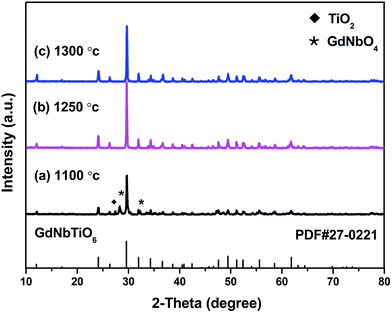 | ||
| Fig. 1 XRD patterns of GdNbTiO6 samples annealed at different temperature; the standard data for GdNbTiO6 (JCPDS no. 27-0221) was used as reference. | ||
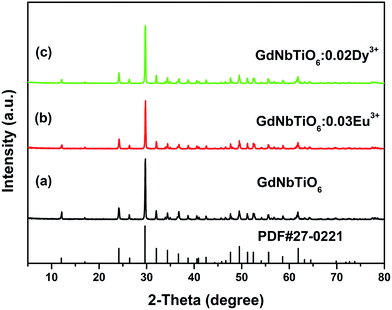 | ||
| Fig. 2 XRD patterns of powder GdNbTiO6 host (a), GdNbTiO6:0.03Eu3+ (b), GdNbTiO6:0.02Dy3+ (c) samples and the reference for the standard data of GdNbTiO6 (JCPDS no. 27-0221). | ||
According to the similarity of effective cationic radii in the same coordination environment, the Y3+ can be substituted by the Gd3+ ion. Comparisons between GdNbTiO6 and YNbTiO6 in lattice parameters and powder XRD patterns show that the two compounds are probably isostructural. Therefore, taking YNbTiO6 as the preliminary crystal structural model, we refined the structure parameters of GdNbTiO6:0.03Eu3+ and GdNbTiO6:0.02Dy3+ from the powder XRD data by the Rietveld method29,30 within the program FullProf_suit. By the way, we assume that Eu3+, Dy3+ substitute cationic site Gd3+ (4c) according to the formula. The profile range of data used for refinement is 5–130° in 2θ, and the pseudo-Voigt function was used as peak shape function. A total of 37 parameters were refined in the refinement, including background parameters, profile parameters and structural parameters. By the way, the practical content of Eu3+ and Dy3+ have been tested and confirmed near to the nominal composition by ICP. So, the occupation of Eu3+ and Dy3+ was fixed in the process of refinement. The final agreement factors in the structural refinement converged to RB = 7.29%, Rp = 2.0%, Rwp = 2.67% with S = 1.88 for GdNbTiO6:Eu3+ and RB = 7.48%, Rp = 1.97%, Rwp = 2.55% with S = 1.50 for GdNbTiO6:Dy3+, which indicates the structure model is quite right. Fig. 3 shows the final refinement patterns. These results indicate that when Eu3+ or Dy3+ is doped in the GdNbTiO6 host, it remains single phase. Details of Rietveld refinement and crystal data are given in Table 1. Position parameters obtained by the Rietveld refinement are listed in Table 2. The structure of GdNbTiO6:Eu3+/Dy3+ are depicted in Fig. 4. The compound crystallizes in the space group Pbcn and belongs to typical euxenite-type structure with four formula units per unit cell. There are several different coordination environments that Nb5+ and Ti4+ ions share a same crystallographic site, which is coordinated by six neighboring O2− to form a slightly distorted octahedron, and the (Gd/Eu/Dy)3+ ion is surrounded by eight fold O2− ions at site with the lower symmetric CSxy (4) to form an irregular (Gd/Eu/Dy)O813− polyhedron.31 Each of (Gd/Eu/Dy)O813− polyhedral connect with four others by shared corner or edge forming a single layers which divides neighboring Nb(Ti)O6 double layers.
| Formula | GdNbTiO6:0.03Eu3+ | GdNbTiO6:0.02Dy3+ |
|---|---|---|
| a Rp = ∑|yio − yic|/∑|yio|, Rwp = [∑wi(yio − yic)2/∑wiyio2]1/2, Rexp = [(N − P)/∑wiyio2]1/2, S = Rwp/Rexp. | ||
| Sample | Multi-crystal power | Multi-crystal power |
| Diffractometer | Rigaku D/MAX-2500 | Rigaku D/MAX-2500 |
| Radiation type | CuKα | CuKα |
| Monochromator | Graphite | Graphite |
| Wavelength (Å) | 1.5405 | 1.5405 |
| Refined profile range (°2θ) | 5–130 | 5–130 |
| Step size (°2θ) | 0.017 | 0.017 |
| Step scan time per step (s) | 2 | 2 |
| RB | 7.29% | 7.48% |
| Rp | 2% | 1.97% |
| Rwp | 2.67% | 2.55% |
| S | 1.88 | 1.50 |
| Symmetry | Orthorhombic | Orthorhombic |
| Space group | Pbcn | Pbcn |
| a (Å) | 14.6898(9) | 14.6898(8) |
| b (Å) | 5.60476(8) | 5.6039(2) |
| c (Å) | 5.22478(8) | 5.2243(1) |
| V (Å3) | 430.17(3) | 430.07(0) |
| Z | 4 | 4 |
| Atom | Site | x | y | z | Biso (Å2) | Occ |
|---|---|---|---|---|---|---|
| GdNbTiO6:0.03Eu3+ | ||||||
| Gd | 4c | 0 | 0.23625(33) | 0.25 | 0.155(35) | 0.970 |
| Eu | 4c | 0 | 0.23625(33) | 0.25 | 0.155(35) | 0.030 |
| Nb | 8d | 0.16913(14) | 0.31898(29) | 0.82130(31) | 0.071(47) | 0.500 |
| Ti | 8d | 0.16913(14) | 0.31898(29) | 0.82130(31) | 0.071(47) | 0.500 |
| O1 | 8d | 0.09728(62) | 0.43928(135) | 0.53447(201) | −0.736(68) | 1.000 |
| O2 | 8d | 0.09061(60) | 0.10006(159) | 0.90759(187) | −0.303(83) | 1.000 |
| O3 | 8d | 0.26120(61) | 0.13728(149) | 0.64002(162) | −0.050(83) | 1.000 |
![[thin space (1/6-em)]](https://www.rsc.org/images/entities/char_2009.gif) |
||||||
| GdNbTiO6:0.02Dy3+ | ||||||
| Gd | 4c | 0 | 0.23672(34) | 0.25 | 0.220(35) | 0.980 |
| Dy | 4c | 0 | 0.23672(34) | 0.25 | 0.220(35) | 0.020 |
| Nb | 8d | 0.16914(14) | 0.31764(30) | 0.82110(30) | 0.010(46) | 0.500 |
| Ti | 8d | 0.16914(14) | 0.31764(30) | 0.82110(30) | 0.010(46) | 0.500 |
| O1 | 8d | 0.09791(64) | 0.43924(137) | 0.53499(200) | −0.424(277) | 1.000 |
| O2 | 8d | 0.09027(55) | 0.09985(159) | 0.90304(175) | −0.541(256) | 1.000 |
| O3 | 8d | 0.26216(58) | 0.14399(149) | 0.64356(152) | −0.467(216) | 1.000 |
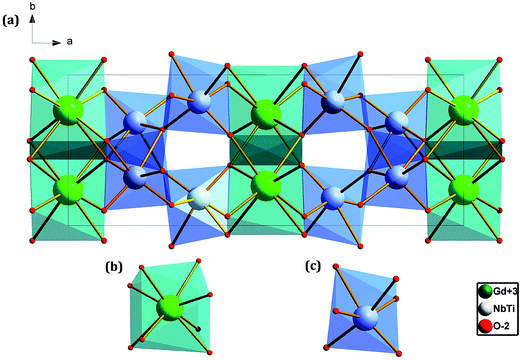 | ||
| Fig. 4 Crystal structure of GdNbTiO6:Eu3+/Dy3+ (a), the coordination geometry of (Gd/Eu/Dy)O8 (b) and Nb(Ti)O6 (c) polyhedral in the host lattice. | ||
3.2 Luminescence characteristics
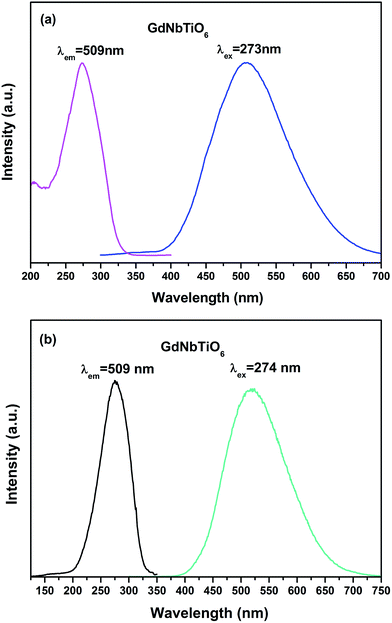 | ||
| Fig. 5 The excitation and emission spectra of GdNbTiO6 under UV (a) and VUV (b) region at room temperature. | ||
There's a variety of studies suggesting that some rare earth fluorescence materials have good scintillation performance, such as Li6Gd(BO3)3:Ce,33 REBa3B9O18,34 and so on. In order to explore the scintillation characteristics of GdNbTiO6 host, the X-ray excited luminescence (XEL) measurements were performed on polycrystalline GdNbTiO6 sample and Bi4Ge3O12 (BGO) at room temperature. Fig. 6 shows a comparison of the X-ray excited luminescence (XEL) spectrum of GdNbTiO6 and Bi4Ge3O12 (BGO) in the same measurement conditions. A broad band in the range of 500–700 nm with peak center at 600 nm is observed in the emission spectra of the GdNbTiO6 pure sample. Compared with the PL emission spectra of GdNbTiO6, the broad band shows an obvious red shift and the centre moves from 509 nm to 600 nm. Furthermore, by comparing the integral area of the emission bands for GdNbTiO6 with that BGO, it is interesting to notice that the light yield is of GdNbTiO6 about 11% of BGO. Therefore, we can conclude that the compound of GdNbTiO6 is a potential scintillator for registration of X-radiation. At present, the scintillator mechanism is concerned; there may be an important relationship between their efficient XEL and the structural features for this compound. In addition, lattice defects such as oxygen vacancies, excess negative charges, and excitons among the band gap, probably play an important role on the scintillating properties of the material. Therefore, a detailed research of the scintillation mechanism will be necessary in the future work.
Fig. 8a exhibits the VUV excitation (monitored the emission 612 nm) and VUV-excited emission spectra (under excitation at 286 nm) of GdNbTiO6:Eu3+. The broad band centering at 281 nm can be assignable to the host absorption band and the charge transfer band of O2− → Eu3+. Fig. 8b exhibits the VUV excitation (monitored the emission 576 nm) and VUV-excited emission spectra (under excitation at 286 nm) of GdNbTiO6:Dy3+. A broad band peaking at 284 nm similar to host excitation spectrum appears to be attributed to the CT from the oxygen ligands to the central niobium atom within the NbO6 octahedral groups. Compared with UV excitation spectrum, a red-shifted of the CT band was observed at VUV excitation spectrum because the resolution of VM504 vacuum monochromator is higher than Xe lamp (VM504 vacuum monochromator is 0.06 nm and Xe lamp is 0.1 nm) and different light source can result in difference.40,41 For another reason, the different filter have been selected according the two different test conditions. All of the emission peaks under VUV excitation are similar to those under UV excitation. In addition, it is obvious that the intensity of the emission spectra is higher than the excitation spectra in the GdNbTiO6:Eu3+/Dy3+ samples, which suggests that there may be the energy transfer between the host and the activated ions.
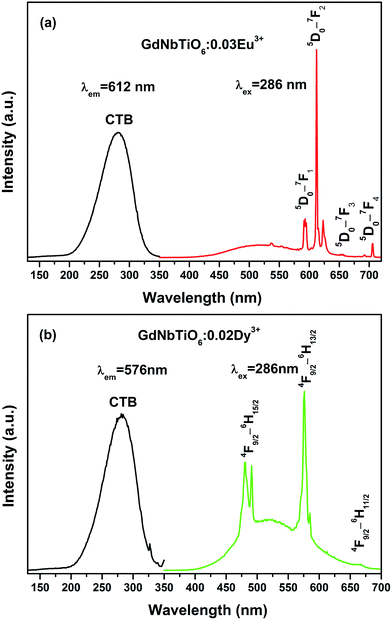 | ||
| Fig. 8 VUV excitation and emission spectra of GdNbTiO6:0.03Eu3+ (a) and GdNbTiO6:0.02Dy3+ (b) under 286 nm at room temperature. | ||
Fig. 9a and b depict luminescence intensity decay curves of 5D0 → 7F2 emission (614 nm) for GdNbTiO6:0.03Eu3+ and 4F9/2 → 6H13/2 emission (577 nm) for GdNbTiO6:0.02Dy3+ phosphors after irradiation at 273 nm. The corresponding luminescent decay times can be well fitted by a second-order exponential decay mode with the following equation:42,43
| I = I0 + A1 × exp(−t/t1) + A2 × exp(−t/t2) | (1) |
 | (2) |
The effective lifetime values were calculated to be 0.056 ms (t1 = 0.178 ms, t2 = 0.008 ms) and 0.045 ms (t1 = 0.009 ms, t2 = 0.115 ms) for GdNbTiO6:Eu3+ and GdNbTiO6:Dy3+ phosphors, respectively. The both decay were be found to be a second-order exponential decay, which also indicates that there are two luminescence centers in GdNbTiO6:Eu3+/Dy3+ crystal lattice, implying two mechanisms for the PL processes. It is completely in conformity with the crystal structure information of GdNbTiO6:Eu3+/Dy3+. In addition, we investigated the decay curves and lifetimes of host emission with the increasing Eu3+/Dy3+ (x = 0, 0.01, 0.03, 0.05; y = 0, 0.01, 0.03, 0.05) concentration in GdNbTiO6:xEu3+/yDy3+ samples as shown in Fig. 9c and d. The luminescence decay curve can also be fitted successfully by a second-order exponential function. On the basis of eqn (1) and (2), we can observe that the average decay times of host emission is 23 μs without any doping of activation ions. The average lifetimes of host are determined to be 22.76, 21.85, 17.07 μs for Eu3+ concentrations of 0.01, 0.03 and 0.05, respectively. For GdNbTiO6:yDy3+ phosphors, we obtain values of 21.64, 21.35, 16.94 μs for y = 0.01, 0.03 and 0.05, respectively. With the increasing concentration of dopant ions, the value of decay time of host emission monotonously decrease in the GdNbTiO6:Eu3+/Dy3+ system, which can well certify the existence of energy transfer from host to activators.
Fig. 10 exhibits the corresponding CIE chromaticity diagram of the GdNbTiO6, Gd(1−x)NbTiO6:xEu3+ and Gd(1−y)NbTiO6:yDy3+ samples under 273 nm UV excitation. It can be found that the GdNbTiO6 samples can emit bright cyan and the chromaticity coordinate is x = 0.258, y = 0.398 (point 0). The CIE chromaticity coordinates change from x = 0.397, y = 0.422 (point 1) to x = 0.534, y = 0.379 (point 5) by changing the doping concentration of Eu3+ from x = 0.01 to x = 0.1 in Gd(1−x)NbTiO6:xEu3+ phosphors and the corresponding luminescence color can change from yellow to red. The obtained Eu3+ ions doped GdNbTiO6 phosphors emerge the advantage of multicolor emission in the visible region. The CIE chromaticity coordinates of Gd(1−y)NbTiO6:yDy3+ are just gathered around point 10 and the luminescence color have no obvious change. All of obtained chromaticity coordinates excited at 273 nm are list in Table 3.
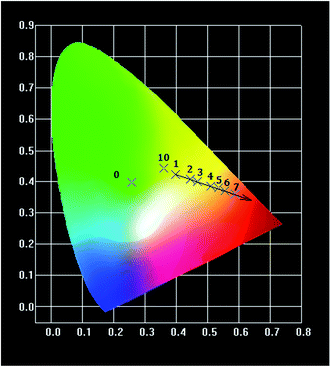 | ||
| Fig. 10 The corresponding CIE chromaticity diagram of the GdNbTiO6, Gd(1−x)NbTiO6:xEu3+ and Gd(1−y)NbTiO6:yDy3+ samples under UV excitation. | ||
| No. of points | GdNbTiO6:xEu3+/yDy3+ | CIE (x, y) |
|---|---|---|
| 0 | x = 0 | (0.258, 0.398) |
| 1 | x = 0.01 | (0.397, 0.422) |
| 2 | x = 0.02 | (0.444, 0.407) |
| 3 | x = 0.03 | (0.467, 0.399) |
| 4 | x = 0.04 | (0.511, 0.384) |
| 5 | x = 0.05 | (0.534, 0.379) |
| 6 | x = 0.07 | (0.554, 0.371) |
| 7 | x = 0.1 | (0.588, 0.359) |
| 8 | y = 0.01 | (0.348, 0.436) |
| 9 | y = 0.02 | (0.357, 0.443) |
| 10 | y = 0.03 | (0.361, 0.443) |
| 11 | y = 0.04 | (0.364, 0.442) |
| 12 | y = 0.05 | (0.343, 0.449) |
3.3 Energy transfer mechanism
In our experiment, as shown in Fig. 7, there are overlaps between the host emission spectra and the excitation spectrum of Eu3+/Dy3+. Obviously, there is the energy transfer between the host and the doped ions. The different energy transfer mechanism determines the luminescence properties of oxide phosphors doped with activators, including radiation reabsorption transfer, exchange interaction, and multipolar interactions.44,45 For rare earth ions, the exchange interaction become effective only when the distance between activators is about 5 Å or shorter.46 The multipolar interaction have three kinds including dipole–dipole (d–d), dipole–quadrupole (d–q) and quadrupole–quadrupole (q–q) interaction.47 Doping concentration is a considerable factor affecting luminescence performance and luminescence mechanism. With Eu3+ content from 1 mol% to 10 mol%, the Eu3+ concentration dependence of the emission intensity of 5D0 → 7F2 transition (614 nm) under 273 nm excitation increases in Fig. 11a. The Dy3+ concentration dependence of the emission intensity of 4F9/2 → 6H15/2 transition (482 nm) and 4F9/2 → 6H13/2 transition (577 nm) under 273 nm excitation are shown in Fig. 11b. The effect of two emission peaks influenced by Dy3+ concentration is very similar. The emission intensities of GdNbTiO6:Dy3+ phosphors constantly increase with increasing Dy3+ ion concentration, however, the emission intensities of host clearly decrease, which also suggests that the energy transfer from the host to the doped ions. In order to further confirm the type of energy transfer mechanism in the host, the relationship of doped ions concentration and photoluminescence quantum efficiencies is discussed with a suitable method according to Dexter's energy transfer expressions of multipolar interaction and Reisfeld's approximation. The model can be described as follows:48
 | (3) |
 | (4) |
On the other hand, in Eu3+/Dy3+-doped GdNbTiO6 phosphors, the energy transfer efficiencies (ηET) from host to the activators can be calculated using the formula ηET = 1 − IS/IS0, where ηET is the energy transfer, and IS and IS0 are the corresponding luminescence intensities of the host in the with and without the activators, respectively.49 The ηET values constantly increase to reach maximums at 98% depicted in Fig. 11e, which reveals the energy transfer rate from the Nb(Ti)O6 group in the host to the Eu3+ becomes more efficient with the increasing concentration of Eu3+ ion. When the doping concentrations of Dy3+ increase from 0.01 to 0.05, the energy transfer rate from phosphors the Nb(Ti)O6 group to Dy3+ in the host increases from 60.88% to 83.26% shown as Fig. 11f.
Fig. 12 shows a simple model describing the intrinsic emission process in Nb(Ti)O6 group, the energy transfer from Nb(Ti)O6 group charge transfer band to Eu3+ and Dy3+ ions and the characteristic emission energy levels of Eu3+ and Dy3+ ions in GdNbTiO6. For GdNbTiO6 sample, under 273 nm UV radiation, the GdNbTiO6 host absorb UV radiation and then a charge transfer from O2− ligands to Nb5+ or (Ti4+) ions occurs in the crystal lattice giving its broad emission band with the center at 509 nm. When doping with Eu3+/Dy3+ ions in GdNbTiO6 host lattice, the excitation energy is transferred from O2− ligands to Nb5+ or (Ti4+) ions charge transfer band to the excited states of Eu3+ or Dy3+ ions, resulting in the increases of characteristic emission intensities of activators.50
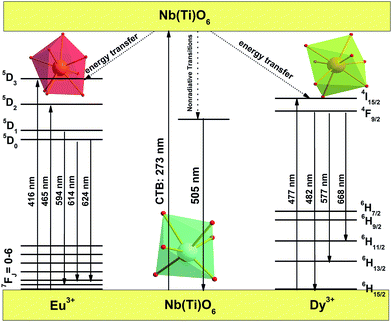 | ||
| Fig. 12 A simple model illustrating the intrinsic emission process in Nb(Ti)O6 group, the energy transfer from host to Eu3+ and Dy3+ ions, and the characteristic of Eu3+ and Dy3+ ions in GdNbTiO6. | ||
4. Conclusion
In conclusion, we have successfully synthesized self-activated GdNbTiO6 and Eu3+/Dy3+ doped GdNbTiO6 phosphors by solid-state reaction. Structural refinement indicates that Eu3+/Dy3+ ion in the GdNbTiO6 host lattice is preferred to occupy the site of Gd3+. The luminescence properties of undoped and Eu3+/Dy3+ doped GdNbTiO6 phosphors were investigated under UV and VUV excitation in detail. Under the UV excitation of 273 nm, GdNbTiO6 phosphors have a broad band peaking at 509 nm, which is due to the luminescence centre of Nb(Ti)O6 group in the host lattice. Eu3+ and Dy3+ ions in the matrix of GdNbTiO6 emitted intense red and yellow-green light under UV excitation. In the meantime, the energy transfer mechanisms from the Nb(Ti)O6 group of the host to Eu3+ and Dy3+ ions have been confirmed to be a resonant type through a dipole–dipole interaction. Furthermore, the VUV spectrum of GdNbTiO6, GdNbTiO6:Eu3+, and GdNbTiO6:Dy3+ are similar to their PL spectrum, which can also illustrates the existence of energy transfer from the host to Eu3+/Dy3+ ions. In addition, XEL measurements showed the light yield of GdNbTiO6 is about 11% as large as that of BGO and the compound of GdNbTiO6 is a potential scintillator for registration of X-radiation. Considering the chemical stability, emission wavelength range and luminescence intensity of the self-activated GdNbTiO6 and Eu3+/Dy3+-activated GdNbTiO6, these materials are good candidates for the further study and lighting application system.Acknowledgements
Financial supports by the National Natural Science Foundation of China (Grant number 51472273), BSRF, and Department for Science and Technology of Hunan province (Grant number 2014FJ4099) are gratefully acknowledged. The work was also supported by grants from the Project of Innovation-driven Plan in Central South University (Grant number 2015CX004).Notes and references
- H. A. Hoppe, Angew. Chem., Int. Ed., 2009, 48, 3572–3582 CrossRef PubMed.
- C. R. Ronda, J. Alloys Compd., 1995, 225, 534–538 CrossRef CAS.
- C. Feldmann, T. Jüstel, C. R. Ronda and P. J. Schmidt, Adv. Funct. Mater., 2003, 13, 511–516 CrossRef CAS.
- J. C. Bunzli and C. Piguet, Chem. Soc. Rev., 2005, 34, 1048–1077 RSC.
- S. V. Eliseeva and J. C. Bunzli, Chem. Soc. Rev., 2010, 39, 189–227 RSC.
- G. Ju, Y. Hu, L. Chen, X. Wang, Z. Mu, H. Wu and F. Kang, J. Alloys Compd., 2011, 509, 5655–5659 CrossRef CAS.
- M. K. Ekmekçi, M. Erdem, A. S. Başak, M. İlhan and A. Mergen, Ceram. Int., 2015, 41, 9680–9685 CrossRef.
- V. R. Bandi, B. K. Grandhe, H.-J. Woo, K. Jang, D.-S. Shin, S.-S. Yi and J.-H. Jeong, J. Alloys Compd., 2012, 538, 85–90 CrossRef CAS.
- N. Zhang, C. Guo and H. Jing, RSC Adv., 2013, 3, 7495 RSC.
- K. Pavani, J. S. Kumar, T. Sasikala, B. C. Jamalaiah, H. J. Seo and L. R. Moorthy, Mater. Chem. Phys., 2011, 129, 292–295 CrossRef CAS.
- Y. Tian, B. Chen, B. Tian, R. Hua, J. Sun, L. Cheng, H. Zhong, X. Li, J. Zhang, Y. Zheng, T. Yu, L. Huang and Q. Meng, J. Alloys Compd., 2011, 509, 6096–6101 CrossRef CAS.
- M. İlhan and M. K. Ekmekçi, J. Solid State Chem., 2015, 226, 243–249 CrossRef.
- J. Zhu, Z. Xia, Y. Zhang, M. S. Molokeev and Q. Liu, Dalton Trans., 2015, 44, 18536–18543 RSC.
- G. Blasse and A. Bril, Phys. Lett., 1966, 23, 440–441 CrossRef CAS.
- Z. W. Zhang, D. Q. Ma, Y. Yue, M. Z. Ma and R. P. Liu, J. Alloys Compd., 2015, 636, 113–116 CrossRef CAS.
- A. I. Komkov, Dokl. Akad. Nauk SSSR, 1963, 148, 1182 CAS.
- H. Weitzel and H. Schroecke, Z. Kristallogr., 1980, 152, 69–82 CrossRef CAS.
- K. Shinomiya, N. Inokuchi, J. N. Gnabre, M. Muto, Y. Kabasawa, H. M. Fales, Y. Ito, H. G. Gallagher, X. Qi and R. Illingworth, J. Cryst. Growth, 1996, 160, 111–118 CrossRef.
- X. Qi, H. G. Gallagher, T. P. J. Han and B. Henderson, J. Cryst. Growth, 1997, 180, 73–80 CrossRef CAS.
- S. Solomon, M. Kumar, K. P. Surendran, M. T. Sebastian and P. Mohanan, Mater. Chem. Phys., 2001, 67, 291–293 CrossRef CAS.
- K. P. Surendran, P. Mohanan and M. T. Sebastian, J. Eur. Ceram. Soc., 2003, 23, 2489–2495 CrossRef CAS.
- Y. Shi, Y. Wang and Z. Yang, J. Alloys Compd., 2011, 509, 3128–3131 CrossRef CAS.
- Q. Ma, A. Zhang, M. Lu, Y. Zhou, Z. Qiu and G. Zhou, J. Phys. Chem. B, 2007, 111, 12693–12699 CrossRef CAS PubMed.
- Q. Ma, M. Lu, P. Yang, A. Zhang and Y. Cao, Luminescence, 2014, 29, 386–392 CrossRef CAS PubMed.
- X. Zhang, G. Zhou, J. Zhou, H. Zhou, P. Kong, Z. Yu and J. Zhan, RSC Adv., 2014, 4, 13680 RSC.
- J. L. Qiang Su and B. Li, J. Alloys Compd., 1995, 225, 120–123 CrossRef.
- X. Xiao and B. Yan, J. Non-Cryst. Solids, 2005, 351, 3634–3639 CrossRef CAS.
- H. C. Yang, C. Y. Li, H. He, Y. Tao, J. H. Xu and Q. Su, J. Lumin., 2006, 118, 61–69 CrossRef CAS.
- H. M. Rietveld, Acta Crystallogr., 1967, 22, 151–152 CrossRef CAS.
- H. M. Rietveld, Phys. Scr., 2014, 89, 098002 CrossRef.
- Q. Ma, M. Lu, P. Yang, A. Zhang and Y. Cao, Mater. Res. Bull., 2013, 48, 3677–3686 CrossRef CAS.
- Y. Zhang, D. Geng, X. Li, J. Fan, K. Li, H. Lian, M. Shang and J. Lin, J. Phys. Chem. C, 2014, 118, 17983–17991 CAS.
- I. N. Ogorodnikov and V. A. Pustovarov, J. Lumin., 2013, 134, 113–125 CrossRef CAS.
- C.-J. Duan, X.-J. Wang and J.-T. Zhao, J. Appl. Phys., 2007, 101, 023501 CrossRef.
- N. Zhang, C. Guo, J. Zheng, X. Su and J. Zhao, J. Mater. Chem. C, 2014, 2, 3988 RSC.
- Y. Luo, Z. Xia, B. Lei and Y. Liu, RSC Adv., 2013, 3, 22206 RSC.
- R. Cao, H. Xu, D. Peng, S. Jiang, Z. Luo, W. Li and X. Yu, Superlattices Microstruct., 2015, 88, 5–11 CrossRef CAS.
- M. M. Kumar, R. H. Krishna, B. M. Nagabhushana and C. Shivakumara, Spectrochim. Acta, Part A, 2015, 139, 124–129 CrossRef PubMed.
- G. Ju, Y. Hu, L. Chen, X. Wang, Z. Mu, H. Wu and F. Kang, J. Lumin., 2012, 132, 1853–1859 CrossRef CAS.
- L. Wang and Y. Wang, J. Alloys Compd., 2006, 422, 305–307 CrossRef CAS.
- L. He and Y. Wang, J. Alloys Compd., 2007, 431, 226–229 CrossRef CAS.
- M. Shang, D. Geng, X. Kang, D. Yang, Y. Zhang and J. Lin, Inorg. Chem., 2012, 51, 11106–11116 CrossRef CAS PubMed.
- G. M. Cai, J. J. Fan, H. K. Li, Z. Zhao, L. M. Su and Z. P. Jin, J. Alloys Compd., 2013, 562, 182–186 CrossRef CAS.
- V. Rao Bandi, B. K. Grandhe, M. Jayasimhadri, K. Jang, H.-S. Lee, S.-S. Yi and J.-H. Jeong, J. Cryst. Growth, 2011, 326, 120–123 CrossRef.
- D. Li, Y. Wang, X. Zhang, G. Shi, G. Liu and Y. Song, J. Alloys Compd., 2013, 550, 509–513 CrossRef CAS.
- X. Zhang, Y. Chen, S. Zeng, L. Zhou, J. Shi and M. Gong, Ceram. Int., 2014, 40, 14537–14541 CrossRef CAS.
- Y. Zhang, W. Gong, J. Yu, H. Pang, Q. Song and G. Ning, RSC Adv., 2015, 5, 62527–62533 RSC.
- C. H. Chen, C. L. Liu and S. T. Chung, Opt. Lett., 2013, 38, 5315–5318 CrossRef PubMed.
- X. Liu, Y. Lü, C. Chen, S. Luo, Y. Zeng, X. Zhang, M. Shang, C. Li and J. Lin, J. Phys. Chem. C, 2014, 118, 27516–27524 CAS.
- M. Yang, X. Zhao, Y. Ji, F. Liu, W. Liu, J. Sun and X. Liu, New J. Chem., 2014, 38, 4249 RSC.
| This journal is © The Royal Society of Chemistry 2016 |

